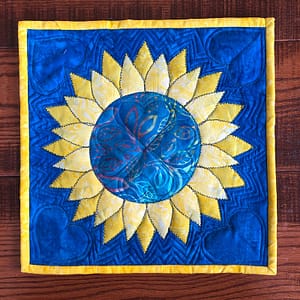Like so many others, I found myself glued to the news this weekend, looking for anything positive. The range of my emotions ran from anger and disgust to sadness and helplessness. There were glimpses of hope, pride and encouragement sprinkled in there as well. One thing I knew for sure is that I couldn’t just watch, I felt the need to do something. There wasn’t much I could do but show my support in some way.
On Sunday, for my mental health, I created the Solidarity Sunflower. The sunflower is the Ukrainian symbol. Their national colors are blue and yellow. These two elements used for Solidarity Sunflower. Once I finished making the mini quilt, I plastered all over my social media. With the help of some other quilters the image was shared widely. Then, I thought wouldn’t it be great if others could do the same and make their own version. To accomplish this, the Solidarity Sunflower pattern is free on my website. But what if people hadn’t done fusible applique before? They would need more detailed instructions. Those detailed instructions for Solidarity Sunflower are now available on YouTube.
The quilt was made from scraps of recent projects. The background fabric is Hoffman’s 1895-123 Lapis. The petals, center and binding are from Timeless Treasures’ Tonga Tropical collection. I used a single layer of cotton batting. To make the project quickly, I used HeatnBond FeatherLite EZ-Print Iron-On Adhesive Sheets. These fusible sheets fit provided a shortcut to applying fusible and cutting templates. You could also use a Cricut or other die cutting machine or Sue Pelland’s Leaves Galore rulers. If you need image files, just let me know and I can make those available to you.
Once the pieces were cut, they were fused together to make a motif. The easiest way to make the motif is to put the layout template from the pattern under a transparent non-stick mat. Two of my favorites are the Goddess Sheet and the Gypsy Quilter Applicut mat. After the pieces are placed, they are fused together with a hot, dry iron. Once cool, they are peeled from the mat and placed on the background fabric, where they are fused again. When fusing, follow the instructions on the package and test a piece before trying the project. Fusing is a Goldilocks process. Too hot or too long and it won’t fuse. Too cool or too quick and it won’t fuse. You need to find what works with your iron.
After fusing, I made a quilt sandwich (top, batting and backing) and basted them together along the edges. Then, I used some Navy Sulky 40 wt Rayon Thread to secure the appliques. I used one of the fancy stitches from my Viking Sapphire. A simple blanket stitch works well too! This quilt as you go technique worked well and sped up the process.
Then, I used some chalk and a paper heart template I made to draw four hearts in the center and one heart in each corner. I used my domestic sewing machine to trace the hearts as quilting. The same Sulky Rayon thread was used. I also echoed the petals to add a little more quilting to the background. To remove the chalk, I use a scrubbing sponge. It was finished with a simple 2 1/2-inch binding. Sometimes simple is best.
Would you like to show your support? Download your free pattern and make your own Solidarity Sunflower. Then, post it on social media. For me, it was much more productive than trolling the news all day.
Happy Quilting!
Laureen

